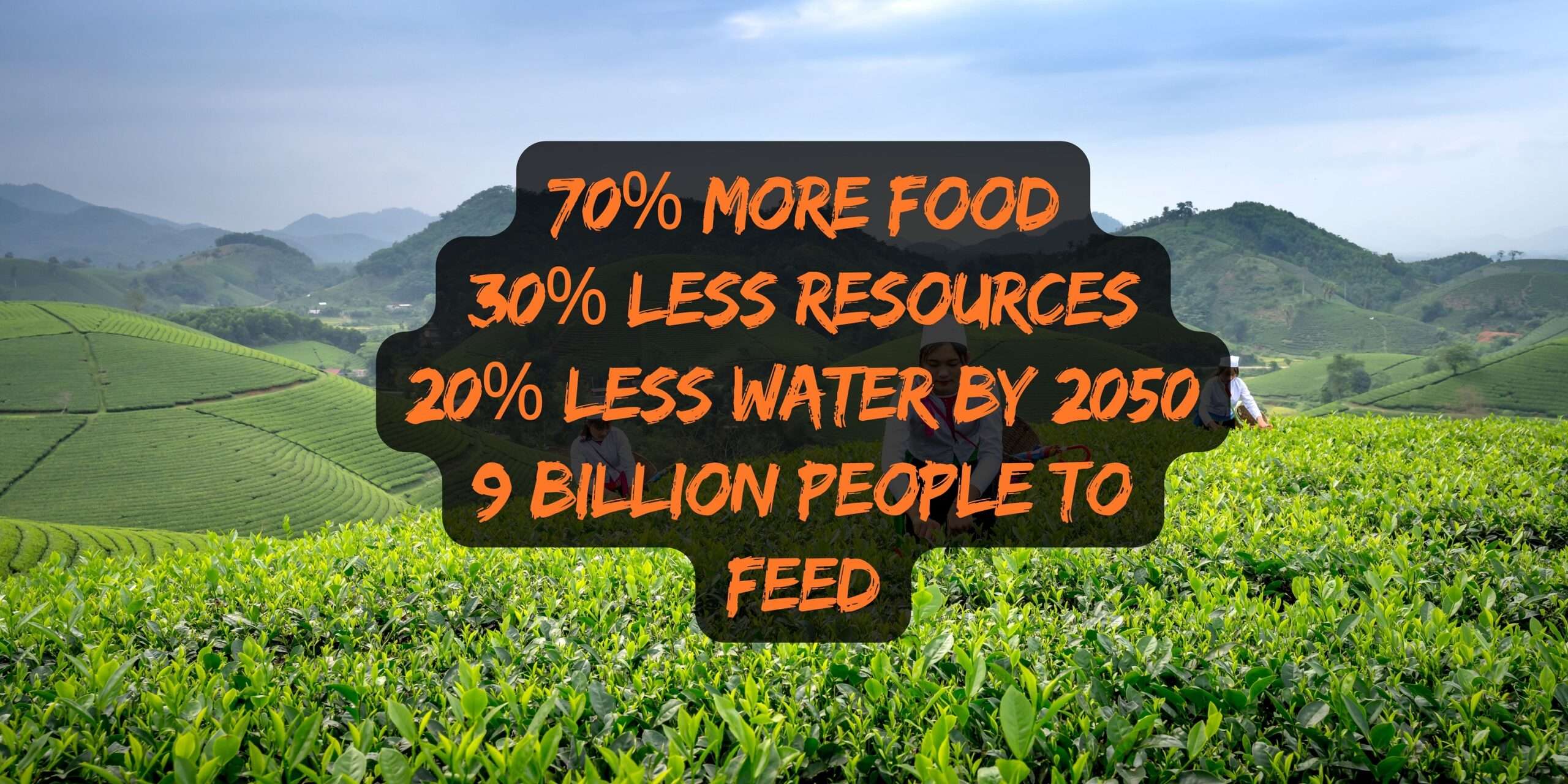- 21 January 2025
- No Comment
- 462
Can Agriculture Meet the Needs of a Growing Global Population?

The 21st century presents agriculture with an extraordinary challenge: how to feed a world population projected to exceed 9 billion by 2050 while addressing dwindling natural resources, a smaller rural workforce, and the escalating impacts of climate change. Global food production must rise by an estimated 70% to meet demand, all while urbanization accelerates and rural populations shrink.
This growing demand puts immense pressure on traditional farming methods, which must now evolve to be more efficient, sustainable, and adaptable. Agriculture isn’t just about producing food anymore, it’s about balancing economic development, environmental responsibility, and social equity.
In this high-stakes scenario, renewable energy is emerging as a beacon of hope. By integrating solar, wind, and bioenergy into farming practices, we can transform agriculture into a powerhouse of sustainability and innovation.
Let’s explore how sustainable agricultural practices and renewable energy are reshaping the farming landscape, addressing global challenges, and offering farmers the tools they need to thrive in the face of change.
Key Sustainable Agriculture Practices
Sustainable farming practices are reshaping the way we grow food, protect the environment, and support communities. Here are seven essential practices that are making a difference:
1. Crop Rotation and Diversification
Rotating and diversifying crops on the same land breaks pest cycles, boosts soil fertility, and improves moisture retention.
Example: After harvesting corn, planting nitrogen-fixing legumes like beans restores the soil’s balance.
2. Organic and Conservation Farming
This combines organic methods with conservation practices to nurture the soil and ecosystem while minimizing synthetic inputs and soil disruption.
Example: Organic farming emphasizes natural compost and biodiversity, while no-till farming keeps crop residues intact, enhancing soil health.
3. Agroforestry
Integrating trees and shrubs with crops or livestock maximizes land use, supports biodiversity, and prevents deforestation.
Example: Growing coffee under a canopy of banana trees promotes shade-loving plants and reduces soil erosion.
4. Sustainable Livestock and Integrated Systems
Holistic management of livestock ensures healthier animals, reduced emissions, and better land recovery.
Example: Rotational grazing allows pastures to regenerate, improving soil quality and reducing methane emissions.
5. Efficient Water Management
Optimizing water use through advanced systems ensures conservation and healthier crops.
Example: Drip irrigation delivers water directly to roots, reducing evaporation and waste.
6. Natural Pest and Soil Fertility Solutions
Using biological pest control and cover crops minimizes chemical dependency while enriching the soil.
Example: Ladybugs control aphids naturally, and clover prevents erosion while adding nutrients to the soil.
7. Circular Systems and Waste Recycling
Closed-loop systems like aquaponics and composting turn waste into valuable resources, promoting efficiency.
Example: Fish waste provides nutrients for plants in aquaponics, while plants purify water for fish tanks.
The selection of these sustainable agriculture practices was guided by the following considerations, ensuring they are impactful, practical, and relatable to a wide range of farming scenarios:
Broader Impact on Sustainability Goals
The chosen practices address critical challenges like soil health, water conservation, biodiversity, and climate change mitigation. They are foundational to achieving sustainability and are widely applicable across different regions and farming systems.
Simplified and Integrated Practices
By grouping complementary techniques like organic farming with conservation tillage or combining agroforestry with biodiversity goals, the focus is on presenting holistic systems rather than isolated strategies.
Global Relevance
These practices are versatile and can be adapted to diverse agricultural contexts, from smallholder farms in developing countries to large-scale commercial operations. They reflect global efforts to enhance food security while minimizing environmental impact.
Ease of Adoption
The selected practices are realistic and achievable for farmers with varying levels of resources and expertise. For instance, crop rotation and water management require relatively low investment but deliver significant results.
Focus on Innovation
Practices like aquaponics, agroforestry, and biological pest control represent innovative approaches that resonate with modern sustainability efforts as forward-thinking solutions.
The Intersection of Farming and Renewable Energy
Farming has traditionally relied heavily on fossil fuels for powering machinery, irrigation systems, and storage facilities. This dependency has contributed to greenhouse gas emissions and increased operational costs for farmers. Renewable energy sources, such as solar, wind, and biogas, offer a sustainable alternative. By harnessing these resources, farmers can reduce their reliance on non-renewable energy, lower costs, and contribute to a healthier planet.
Why Sustainable Farming Matters
Sustainable farming goes beyond just producing food, it’s about preserving ecosystems, improving soil health, and ensuring future generations can meet their food needs. However, achieving these goals requires innovation. Renewable energy technologies play a crucial role in helping farmers adopt practices that conserve water, reduce emissions, and enhance biodiversity.
Benefits of Renewable Energy in Agriculture
- Cost Savings: Renewable energy reduces electricity and fuel costs. For instance, solar panels can power irrigation pumps, significantly lowering utility bills.
- Energy Independence: By generating their own energy, farmers become less reliant on external power sources and are shielded from fluctuating energy prices.
- Reduced Carbon Footprint: Utilizing clean energy decreases greenhouse gas emissions, aligning agricultural practices with global climate goals.
- Enhanced Efficiency: Smart technologies powered by renewable energy, such as automated irrigation systems, optimize resource use and improve crop yields.
Key Renewable Energy Innovations in Agriculture
- Solar-Powered Irrigation Systems Solar panels are increasingly used to power water pumps, enabling farmers to irrigate crops even in remote areas without access to the grid. These systems are efficient, cost-effective, and environmentally friendly.
- Wind Energy for Farms Wind turbines are another renewable solution that can generate electricity for farming operations. Larger farms often utilize wind power to run equipment and store excess energy for later use.
- Biogas Production Organic waste from farms, such as manure and crop residues, can be converted into biogas. This renewable energy source can be used for heating, electricity, or even fueling machinery, turning waste into a valuable resource.
- Agrophotovoltaics This innovative approach involves using farmland for both agriculture and solar energy production. Solar panels are installed above crops, providing shade while generating electricity—a win-win for productivity and sustainability.
The Future of Agriculture
Agriculture is more than growing food, it’s a vital tool for reducing hunger, creating jobs, and improving rural livelihoods. To truly harness its potential, we must invest in better infrastructure, support systems for farmers, and programs that uplift vulnerable communities.
For renewable energy to truly revolutionize agriculture, collaboration is essential. Governments, private sectors, and research institutions must work together to:
- Provide subsidies and incentives for farmers adopting renewable energy.
- Develop affordable and scalable renewable energy solutions.
- Educate farmers about the benefits and maintenance of these technologies.
Sustainable farming practices and renewable energy can transform agriculture into a driver of long-term growth and resilience. Together, we can ensure that agriculture not only feeds the world today but also secures a better tomorrow for future generations.
Are you a farmer or a business looking to embrace sustainable practices? Share your challenges or success stories in the comments below. Let’s build a greener future together!
Read more: 1.18 Billion Living Without Electricity
Imagine living in a world where flicking a light switch doesn’t bring brightness, where refrigerators don’t preserve food, and where essential appliances are out of reach. This is the grim reality for 1.18 billion people worldwide who are energy-poor, unable to access or use electricity. This number is even more staggering than the 733 million people recorded in 2020 as having no electricity connection at all. About 1.18 billion people live in areas so dark that even satellites cannot detect any signs of electricity being used. Read more


